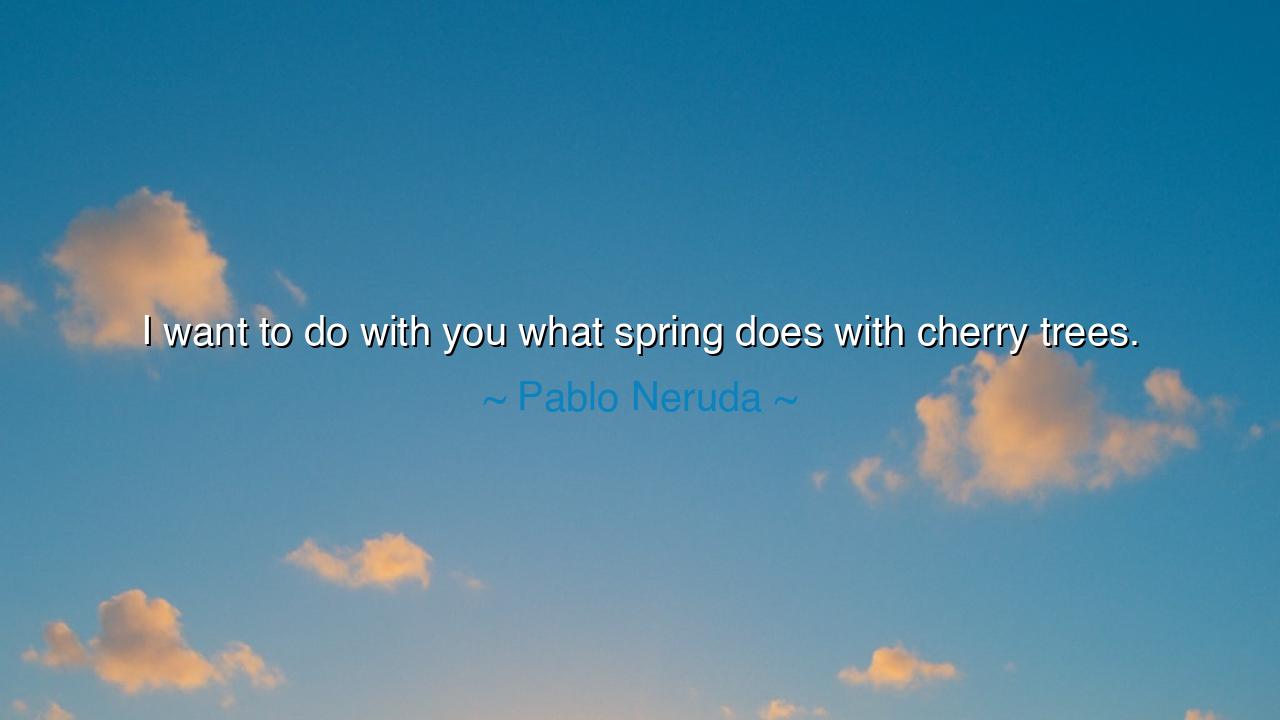
I want to do with you what spring does with cherry trees.






Hear the tender yet eternal words of Pablo Neruda: “I want to do with you what spring does with cherry trees.” At once simple and profound, this line speaks not only of love, but of renewal, transformation, and the power of one soul to awaken life in another. The poet does not speak of mere passion, nor of fleeting desire; he speaks of the force that turns barren branches into blossoms, that brings fragrance where there was silence, that adorns the earth with beauty after the long sleep of winter. To love, in Neruda’s vision, is to be the season of another’s awakening.
The ancients understood spring as more than a time of year; it was the season of rebirth, the triumph of life over death. In Greece, it was the return of Persephone from the underworld, and with her return, the earth flowered once more. In the East, cherry blossoms have long been a symbol of life’s fleeting beauty, a reminder that every moment is precious because it will pass. To say, “I want to do with you what spring does with cherry trees” is to say: I long to be the force that awakens your soul, that clothes you in beauty, that reminds you of your own fleeting but radiant life.
The imagery of the cherry tree is not accidental. In winter, the tree is bare, silent, seemingly lifeless. But when touched by spring, it becomes an emblem of hope, clothed in blossoms so delicate they appear as living snow. In this, Neruda shows us what love at its purest can do: it awakens hidden potential, it brings to bloom what lies dormant, it reveals beauty that was waiting only for the right season to shine. Such is the power of love — not to create life, but to call forth the life already sleeping within.
History bears witness to such awakenings. Consider the story of Dante and Beatrice. Though their encounters were few and fleeting, Beatrice became the spring of Dante’s soul. Through her, he saw the world afresh; through her, he wrote The Divine Comedy, guiding countless generations through hell, purgatory, and into the light of paradise. Beatrice, like spring to the cherry tree, awakened in Dante the full flowering of his genius. Love became the season in which his soul bloomed.
Yet Neruda’s words are not only about romance; they are about transformation itself. To love, whether as friend, mentor, parent, or companion, is to be the spring for another — to encourage growth, to inspire, to remind them of their beauty, to bring joy after sorrow. How many souls, like cherry trees in winter, live bare and silent, waiting for someone to believe in them, to nurture them, to call forth their blossoms? When we love truly, we do not control or possess; we awaken, we liberate, we let the other bloom.
The wisdom here is that true love — whether romantic, platonic, or divine — is creative. It is not satisfied with the surface but seeks the hidden depths. It does not demand change by force but awakens change by presence. Just as spring does not command the cherry tree to flower but simply surrounds it with warmth, so true love does not coerce but invites. This is the difference between love that imprisons and love that liberates: one withers, the other makes bloom.
The lesson is clear: strive to be spring in the lives of others. Be the one whose presence awakens joy, whose words inspire confidence, whose actions nurture growth. Do not seek only what you may receive, but what you may help to blossom. In every relationship, ask yourself: do I bring life, do I bring renewal, do I make the world around me bloom? For the measure of love is not how much it consumes, but how much it creates.
So let Neruda’s words echo in your heart: “I want to do with you what spring does with cherry trees.” Let them remind you that love is not merely desire, but the sacred work of awakening beauty in another. To love in this way is to join the eternal rhythm of creation itself, to become not a season of decay, but a season of flowering, in which every soul you touch may come into full bloom.






AAdministratorAdministrator
Welcome, honored guests. Please leave a comment, we will respond soon